

Эти статьи представляют собой краткое изложение исследований и данных на этом сайте

41% women and non-conforming individuals face verbal or physical sexual harassment at work.
On average, 30% of the over 2,000 media professionals surveyed by WAN-IFRA Women in News between November 2020 and September 2021 indicated they had been on the receiving end of verbal and/or physical sexual harassment at work. When segmented by gender, this figure jumps to on average 40% for women and non-gender conforming individuals. On average, 12% of male respondents reported being on the receiving end of sexual harassment.
Disturbingly, on average 1 in 10 of all respondents, indicated that they had been harassed 5 times or more.

1 in 10 respondents indicate they had been harassed 5 times or more.
Another worrisome trend across all 20 markets is an unwillingness to report incidents when they occur. On average, only 1 in 5 incidents of sexual harassment are formally or informally escalated within media organisations.
Also consistent across all 5 regions: an inadequate response rate on behalf of organisations upon receiving a complaint. On average, action is only taken by organisations in just over half of the reported cases. And when action is taken, the most common response is to “warn the perpetrator”.
The most frequently cited perpetrators of sexual harassment are fellow employees (39.3%), followed by direct supervisor (19%) or, a higher management (18.9%)
Verbal Harassment for women
Reporting rates by region also show some variation, with Central America revealing the highest level of reporting, at 26% and the Arab Region showing the lowest, at 15%.
When asked what discouraged reporting, the overwhelming response pointed to a lack of understanding or awareness around avenues to report incidents, and fear of repercussions if incidents are reported. Less than 11% of respondents reported knowing whether their organisations even had a sexual harassment policy.
Over the course of the 12-month study, WAN-IFRA Women in News conducted in-depth interviews with 85 senior media executives from 18 of 20 target countries. A consistent trend identified is the disconnect between perception and reality held by executives when it comes to understanding the scale of the problem within their media organisation or the industry generally in their particular market.
43.5% of the media executives interviewed reported that they themselves had experienced sexual harassment. However within this same group, only 27% feel sexual harassment is still an issue in the industry. This is compounded by a lack of awareness around their own sexual harassment policies: Just over 1 in 10 interviewees knew if their organisations had a sexual harassment policy.
This lack of awareness over the extent of the issue could in part be due to the low levels of reporting (which in itself is a symptom of lack of clarity around how to report an incident when it does arise as outlined above).
There are clear steps that media organisations can take to help equip their management teams with the right tools to address and mitigate sexual harassment in the workplace. A clearly defined and accessible sexual harassment policy is essential. Training managers on how to address incidents in a respectful way when they occur, is another. As an important first step, media managers can better understand the extent of the problem by conducting an anonymous internal survey.
As the findings from this global research demonstrate, sexual harassment remains a pervasive problem in the media industry.
Learn more about what can be done to address sexual harassment in your media organisation here
African media has a sexual harassment problem. But many cases of physical and verbal sexual harassment go unreported because of fear of further victimisation and a lack of confidence in management systems and interventions. When action is taken, results are often underwhelming.
WIN’s latest research, the first phase of a multi-region study, set out to collect credible information about the scale of harassment in news outlets in Africa and to establish what was being done to provide safer newsrooms.
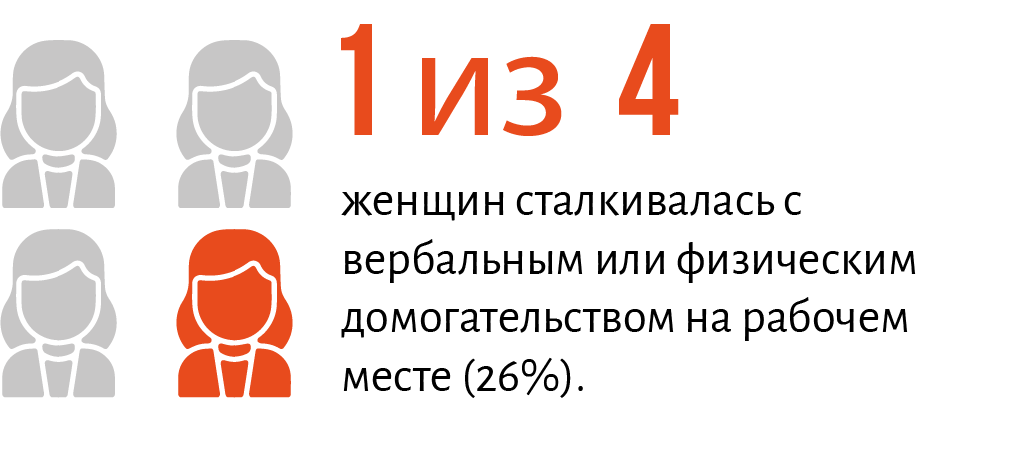
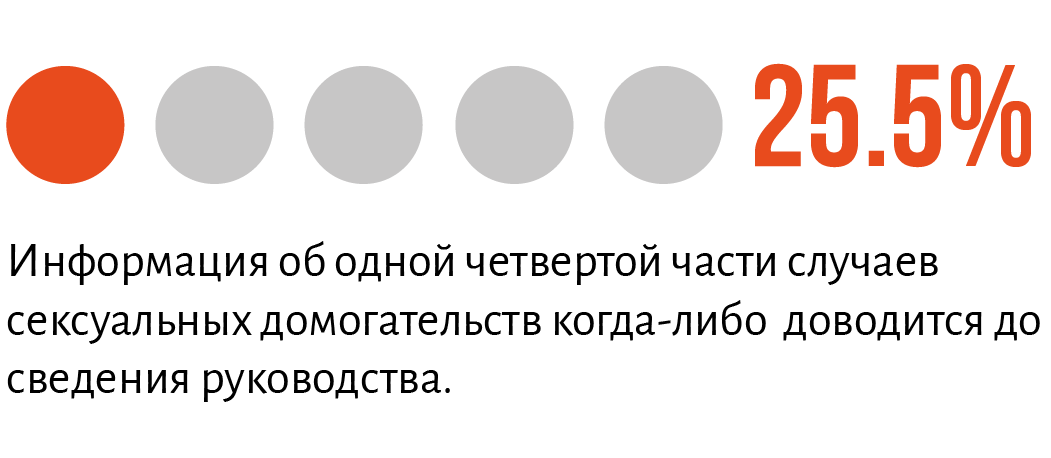
575 survey respondents, from eight countries, namely Kenya, Malawi, Zambia, Zimbabwe, Botswana, Tanzania, Uganda and Rwanda, responded to questions on sexual harassment at work - verbal and/or physical. It found:
Fear prevented many from filing formal complaints. These were the common concerns:
The absence of and lack of awareness of reporting mechanisms also explained inaction.
Almost half, 46.7%, of those surveyed said their organisation had no sexual harassment policy, 35.9% were unaware of what was in the policy and just 17.4% were aware of its contents.
Of the 32 managers interviewed 68.7% said their organisation had a sexual harassment policy - 46.7% had been trained on it.
Perhaps the biggest impedance in reporting is that the perpetrators are often managers or supervisors - people with responsibility and power. Survey respondents identified their harassers as fellow employees (in 38.8% of cases) but 22.1% of the time they were direct supervisors and in 19.4% of cases, members of higher management.
When action was taken in 57% of cases reported, the most common organisation response was to warn the perpetrator (46.2%). 14.5% of responses said training was offered and 9.7% had the case dismissed.
“The research highlights a lack of trust in the organisation, or sometimes complete failure of management and systems, to deal effectively with sexual harassment,” said Melanie Walker, WAN-IFRA’s Executive Director, Media Development and Women in News.
“This matters because the less confidence there is in an organisation’s ability to address the problem, fewer people will see value in calling it out, and so the cycle will perpetuate.” There are solutions, however, beginning with owners and managers acknowledging the problem exists and then committing to ensuring a safer working space, not just for women, but for all staff. It is vitally important to change the culture of silence around harassment. And this culture change can only come from the very top.”
In supplementary interviews with 32 media managers, we found
“There are divergent views on the scale of sexual harassment between the survey respondents and managers we interviewed. There is no simple explanation for this - but what is common is that both staff and managers have had first-hand experience of sexual harassment, and in most cases chose not to report it. This suggests fear of victimisation runs alongside a lack of confidence in management systems and any apparent remedies,” said Walker.
Women in News, which offers expert input on how to manage sexual harassment, is starting to see little victories among those media organisations that have begun to actively manage the problem - starting with adopting policies and procedures that the staff can support. “But the numbers are very small and we have a very long way to go before staff are convinced and comfortable that if there are incidents of harassment, they can report them, and action will be taken, without further victimisation,” said Jane Godia, Africa Director of WIN and an expert and trainer managing sexual harassment.
“We are still working on changing perceptions and debunking cultural beliefs that perpetuate sexual harassment,” said Godia.
This research has provided evidence of the need for media organisations to recognise the extent of sexual harassment and put in plans steps to provide a safer working environment.
“It all starts with a conversation on what is and isn’t acceptable behaviour in your media organisation. - being explicit about sexual harassment - sharing definitions, what behaviours are unacceptable, and communicating the right for every employee to be treated equally. It is not enough to have a policy; staff and managers must be trained on what the procedures are for making and managing a complaint. Everyone should be clear about the consequences of sexual harassment. It is far better to be proactive and prepared than pushed into a crisis management position when a case emerges,” said Walker.
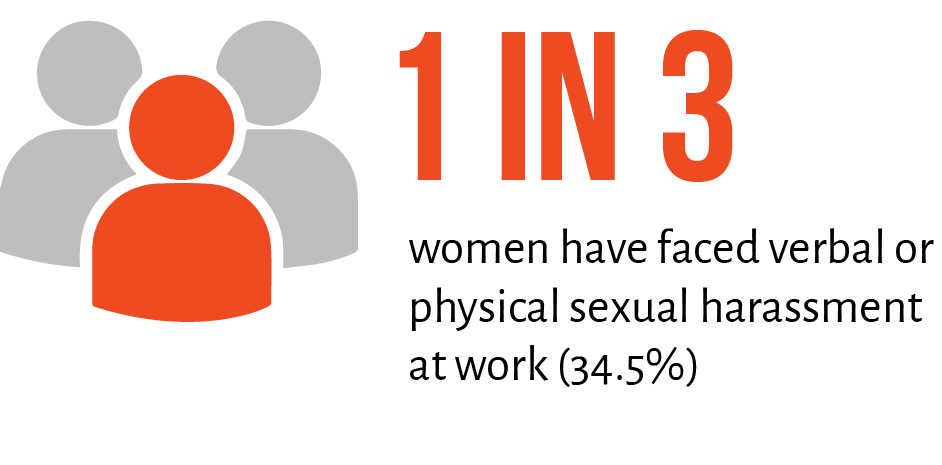
The way media organisations are managed is, generally, influenced by a belief that employees know how to behave. However, the reality is that sexual harassment remains quite prevalent - particularly for women - and often goes unreported. With less than one in six cases being reported to management, a culture of silence and fear persists.
This problem is compounded by a discrepancy between executives and employees on the scale of the problem. Despite one in three women having faced sexual harassment at work, 84.1% of executives interviewed believe sexual harassment isn’t a problem in the news industry. This is a significant perception gap.
These results form part of a multi region-study to provide the evidence of the extent of sexual harassment. The full research will help better understand the similarities and differences facing media in the Global South.

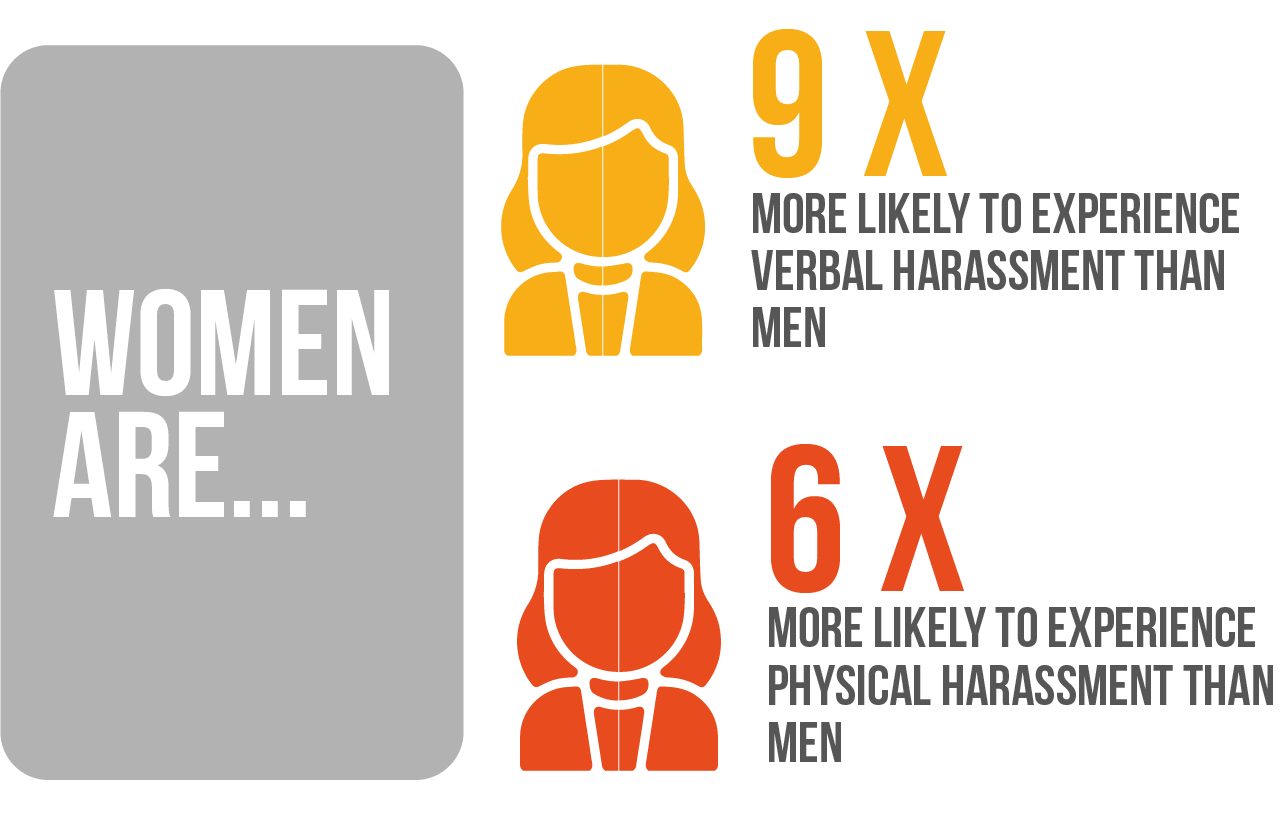
494 survey respondents, from five countries, namely Indonesia, Myanmar, Malaysia, Philippines, and Vietnam, responded to questions on sexual harassment at work - verbal and/or physical. It found:
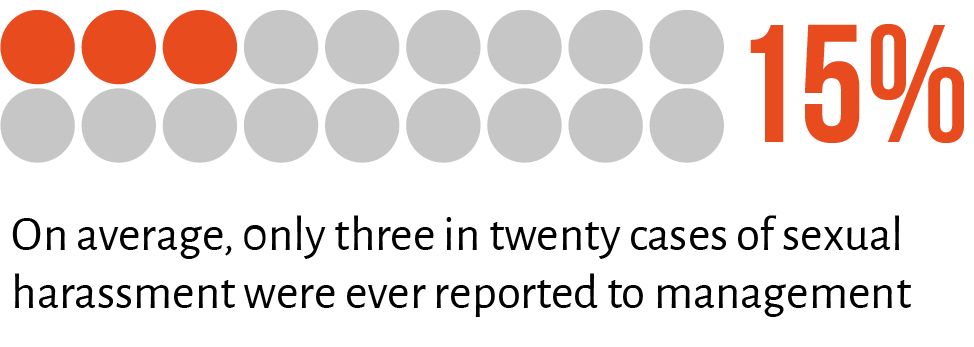
Underreporting of sexual harassment is endemic at both the employee and executive level. Along with the 15% reporting rate of survey respondents, executives themselves only reported incidents that happened to them 33% of the time (six of the 19 executives who had experienced sexual harassment however only two had reported it).
Of course we would like to see action always be taken, but with only 42% of executives indicating they were aware of their company’s sexual harassment policy the results are unsurprising.
In supplementary interviews with 19 media executives, we found
Increasing education about sexual harassment policies and how to implement them are a first step to improving the instances of action being taken. With only three of the eight executives who knew about the policies having been personally trained, this could make a big impact. This is supported by the more than half of executives who called for more training on what constitutes sexual harassment and how to respond.
Perhaps the biggest impedance in reporting is that the perpetrators are often managers or supervisors - people with responsibility and power. Survey respondents identified their harassers as fellow employees (in 35.2 % of cases) but %, 18.6% of the time they were members of higher management and in 12.7% of cases, direct supervisors.
“The research highlights disagreement about the prevalence of sexual harassment in newsrooms. 73.6% of executives believe it isn’t a problem, with an additional 10.5% believing it is a thing of the past. This is in stark contrast to the just over one in three women who have experienced some form of harassment at work - as well as the 4% of men,” said Melanie Walker, WAN-IFRA’s Executive Director, Media Development and Women in News.
“This is problematic because the first step in addressing sexual harassment is understand what it is and agreeing that it exists. We are glad to see executives agreeing that more training is needed to better understand sexual harassment and how to manage it. We are optimistic that continuing to work with media organisations across the region will help redress disagreements or misunderstanding.”
Women in News, which has recently expanded into Southeast Asia, offers expert input on how to manage sexual harassment. Working directly with newsrooms as well as individuals through the Leadership Accelerator, managers and employees can be equipped with the policies and procedures to actively manage the problem. But perhaps even more importantly, individuals get help to understand their rights and media organisations understand their responsibilities. “It is a long road ahead, starting with building a common understanding of what sexual harassment is and why it persisits. Removing it from every newsroom will create safer working environments and ones in which women can more easily thrive,” said Khin Thandar Htay, Southeast Asia Director of WIN.
This research has provided evidence of the need for media organisations to recognise the extent of sexual harassment and put in plans steps to provide a safer working environment.
“It all starts with a conversation on what is and isn’t acceptable behaviour in your media organisation. - being explicit about sexual harassment - sharing definitions, what behaviours are unacceptable, and communicating the right for every employee to be treated equally. It is not enough to have a policy; staff and managers must be trained on what the procedures are for making and managing a complaint. Everyone should be clear about the consequences of sexual harassment. It is far better to be proactive and prepared than pushed into a crisis management position when a case emerges,” said Walker.
Женщины, работающие в российских СМИ, в четыре раза чаще подвергаются сексуальным домогательствам, чем мужчины. Отчет о масштабах сексуальных домогательств в российских медиа показал, насколько распространен этот порок, однако только четверть случаев доводится до сведения руководства.
Исследование, проведенное по заказу Всемирной ассоциации издателей новостей (WAN-IFRA) и программы «Женщины в новостях» (WIN), выявило, что из тех, кто подвергался домогательствам, 31 % подвергались словесным и 14 % ‒ физическим преследованиям.
Опрос, который является частью мирового межрегионального исследования, проведенного в партнерстве с Лондонским городским университетом (City, University of London), был направлен на сбор данных о масштабах сексуальных домогательств в средствах массовой информации в России и установление того, что делается для обеспечения безопасной среды в новостных редакциях. Мы опросили 176 медиапрофессионалов и провели дополнительные углубленные онлайн-интервью с 16 руководителями СМИ.
WIN более 10 лет сотрудничает с журналистами и медиаменеджерами по вопросам борьбы с сексуальными домогательствами. За это время мы собрали множество свидетельств случаев сексуальных домогательств. Но это первый раз, когда мы смогли использовать крупномасштабные данные, чтобы подтвердить уверенность в том, что она распространена повсеместно и является существенным препятствием для здоровой медиаиндустрии, независимо от страны или культурного контекста.


В то время как проблема сексуальных домогательств в редакциях актуальна в гораздо большей степени для женщин, мужчин она тоже не обошла стороной, хотя у них в четыре раза меньше шансов столкнуться с ней. Из числа опрошенных мужчин, 12 процентов подвергались словесным сексуальным домогательствам. Никто из них не подвергался физическому насилию.
В целом чуть менее четверти респондентов (23,4 %) были свидетелями по крайней мере одного случая сексуальных домогательств на работе, но количество сообщений об этих случаях оставалось низким - 25,5 %.
В ходе опроса было установлено:
В России в среднем 25,5 % случаев сексуальных домогательств доводилось до сведения руководства средств массовой информации. Если учесть, что 62 % домогательств исходят от руководства, низкий уровень сообщений о них означает, что большинство обидчиков никогда не привлекается к дисциплинарной ответственности, а потерпевшие никогда не получают поддержки.
Страх: боязнь потерять работу, страх негативных последствий, боязнь мести или позорного клейма - был основной причиной того, чтобы не сообщать об этом. В совокупности это составляет 39,7 % ответов.
Главными индивидуальными причинами были названы отсутствие известных механизмов подачи жалобы (17,1 %) и отсутствие понимания того, что это имеет значение (15,3 %).
Кроме того, когда респонденты сообщали о сексуальных домогательствах, новостные организации принимали меры менее чем в двух третях (62 %) случаев. Наиболее распространенными ответами организаций, когда они принимали меры, были:
Прямых действий против обидчика почти никогда не предпринималось. Об увольнении, переводе и отстранении обидчика сообщалось только один раз. Наиболее распространенным источником сексуальных домогательств были коллеги по работе, за которыми следовало руководство (34,2 %, в совокупности с непосредственным руководителем и вышестоящим руководством).
«Понимание злоупотребления властью имеет решающее значение для понимания того, кто подвергается сексуальным домогательствам и почему. Как правило, это не имеет ничего общего с искренним сексуальным или социальным интересом. Скорее, это происходит там, где существуют неравные отношения, например, между начальником и его подчиненным или между старшим сотрудником и младшим сотрудником», - Мелани Уокер, исполнительный директор программы «Женщины в новостях», WAN-IFRA.
На вопрос, являются ли сексуальные домогательства проблемой в индустрии новостей, 15 руководителей новостных СМИ ответили «нет», а один сказал «возможно». Это резко контрастирует с ответами 35 % женщин, которые сообщили, что подвергались словесным сексуальным домогательствам, и 17 %, которые ответили, что подвергались физическим домогательствам. И этот факт также может объяснить, почему 35 % респондентов заявили, что организационные барьеры, такие как отсутствие механизма подачи жалобы, незнание того, как сообщить о проблеме, или мысль о том, что им не поверят, были причиной того, что они не сообщили о преследованиях, с которыми столкнулись. not knowing how to report or thinking they wouldn’t be believed, were why they didn’t report the harassment they experienced.
Чтобы понять взгляды руководства на распространенность сексуальных домогательств, мы опросили 16 менеджеров и руководителей: 11 женщин и 5 мужчин.
Три женщины заявили, что подвергались сексуальным домогательствам, но ни одна из них не сообщила об этом.
Общее убеждение руководителей в том, что нет необходимости в четкой политике и процедурах в отношении сексуальных домогательств, может объяснить низкий уровень подачи жалоб. Распространенной причиной, чтобы не сообщать об этом, было то, что событие не имело большого значения. Однако, по отношению к словесным домогательствам, один респондент отметил чувство стыда, которое, в соответствии с культурными нормами, заставляет жертв молчать.
«Я не думаю, что сексуальное домогательство - это проблема. Если возникает проблема, сотрудники знают, как защитить себя. Более того, у меня есть женщины, которые будут сопротивляться любому, если это произойдет. Мы все находимся в прозрачной среде; мы видим друг друга», - сказал один из главных редакторов.
«Мне трудно однозначно ответить на этот вопрос. Честный ответ: скорее да, чем нет», - сказал заместитель главного редактора.
На вопрос, сообщал ли кто-либо из их сотрудников о случаях сексуальных домогательств, трое из 16 руководителей ответили утвердительно, и их ответом на обращение было обсуждение инцидента с заинтересованными лицами.
По поводу сокращения числа жалоб один генеральный директор сказал: «С начала движения #MeToo многие мужчины переосмыслили свои действия. Тем не менее, я по-прежнему обеспокоен сексуальными домогательствами и понимаю, что мы можем добиться большего».
Интересно, что, когда мы спросили респондентов, была ли их рабочая среда благоприятной для женщин, 76,2 % выразили частичное или полное согласие с тем, что они могли открыто поговорить со своим руководителем, 88,1 % частично или полностью согласились с тем, что их слушали на работе, и 88,8 % частично или полностью согласились с тем, что они чувствовали себя в безопасности в своей редакции. Однако, по всей видимости, это противоречит их опыту.
В ответ на вопрос о том, считают ли руководители, что их сотрудники чувствуют себя комфортно, сообщая о случаях сексуальных домогательств в свои новостные организации, 12 человек сказали «да».
«Я уверен насчет женщин. Они, конечно, расскажут. Они всегда говорят о своих проблемах: от проблем со здоровьем до личных драм и расставаний. С мужчинами я не так уверена. Мужчина должен решать свои проблемы самостоятельно - таков российский менталитет. Ты не мужчина, если показываешь свою слабость или просишь о помощи», - сказал один генеральный директор.
Убеждения руководителей в том, что сексуальные домогательства не являются проблемой на их рабочем месте, контрастируют с мнениями респондентов, где каждая четвертая женщина сталкивалась с нежелательными словесными или физическими домогательствами на работе.
Респонденты сказали, что обидчиком чаще всего был коллега по работе, но нежелательное внимание оказывалось и со стороны людей, обладающих властью в организации, а именно непосредственных руководителей и высшего руководства.
Общее убеждение руководителей в том, что нет необходимости в четкой политике и процедурах в отношении сексуальных домогательств, может объяснить низкий уровень подачи жалоб. Распространенной причиной, чтобы не сообщать об этом, было то, что событие не имело большого значения. Однако, по отношению к словесным домогательствам, один респондент отметил чувство стыда, которое, в соответствии с культурными нормами, заставляет жертв молчать.
Кроме того, когда их спросили, знают ли они, существует ли в их организациях политика борьбы с сексуальными домогательствами, из 16 руководителей новостных СМИ только двое знали о таком документе. И когда их попросили представить предложения по устранению сексуальных домогательств в индустрии новостей, они сосредоточились на важности общения и создании комфортной атмосферы. Большинство руководителей считает, что такая атмосфера существует на их рабочем месте, поэтому сексуальные домогательства не являются серьезной проблемой.
Результаты исследования выходят за рамки единичных случаев и демонстрируют, что сексуальные домогательства действительно существуют в российских СМИ. Уверенность менеджеров в том, что их рабочие места с их политикой открытого общения не являются очагами домогательств, укрепляет их представление о том, что сексуальные домогательства являются проблемой прошлого, и эта уверенность продолжает создавать небезопасные условия работы для всех их сотрудников.
В первую очередь необходимо убедиться, что руководители действительно понимают, что представляет собой сексуальное домогательство и насколько оно распространено. Только исходя из этого может быть принята политика противодействия домогательствам и изменена культура работы, чтобы искоренить это зло во всех организациях СМИ и, в конечном счете, на всех рабочих местах в целом
«Исследование показало, что многие издатели стараются создать открытую, дружелюбную атмосферу в своих отделах новостей и искренне верят, что это защищает от преследований. Но инциденты могут произойти в любой команде и в любой организации. Важно знать, что делать и как действовать в этом случае, чтобы защитить людей. У вас должны быть механизмы для подачи жалобы, процедуры и правила расследования и возможных ответных действий. Исследование показало, что их не существует или сотрудники не знают о них. АНРИ-Медиа вместе с программой «Исследование показало, что многие издатели стараются создать открытую, дружелюбную атмосферу в своих отделах новостей и искренне верят, что это защищает от преследований. Но инциденты могут произойти в любой команде и в любой организации. Важно знать, что делать и как действовать в этом случае, чтобы защитить людей. У вас должны быть механизмы для подачи жалобы, процедуры и правила расследования и возможных ответных действий. Исследование показало, что их не существует или сотрудники не знают о них. АНРИ-Медиа вместе с программой «Женщины в новостях» WAN-IFRA предпринимает самые первые шаги в этом направлении, чтобы помочь средствам массовой информации создать безопасную бизнес-среду. Например, мы адаптировали и издали «Практическое пособие WIN по противодействию домогательствам в СМИ» с практическими шаблонами и рекомендациями». Анна Кошман, АНРИ-Медиа
Although 85% of sexual harassment incidents go unreported in the Arab media industry - management is starting to take some concrete actions to break the circle of silence.
526 media professionals participated in a survey from February to April 2021 distributed in Egypt, Jordan, Lebanon, and Palestine as part of a multi-region study to provide evidence of sexual harassment in the media industry. Just over half of the participants were women (54%).
On average one in three women have faced some form of sexual harassment at work (35%). More than 50% have experienced verbal harassment. Yet only 12% of incidents are reported. Men are more likely to see action taken on their behalf. On average, 50% of cases reported by men received action from their organisation, compared to 41% for women.
In addition, when asked if their organisation has an anti-sexual harassment policy, only 7% said there is one in place and they are aware of it.
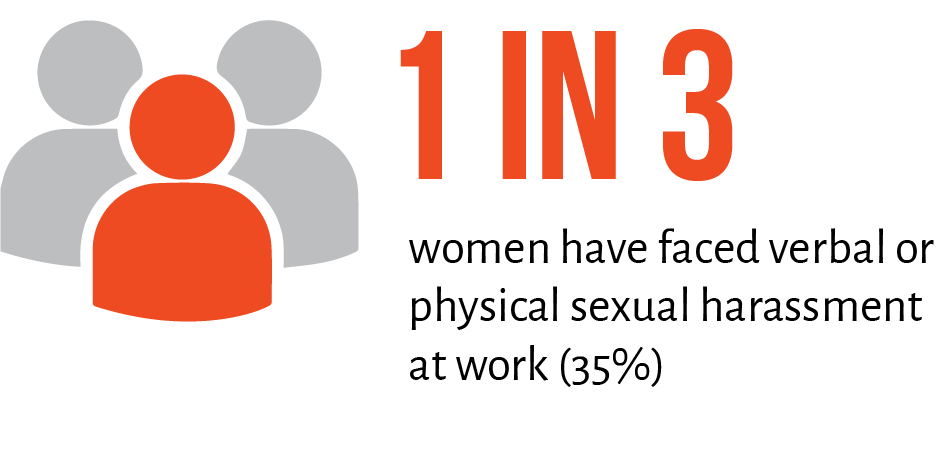

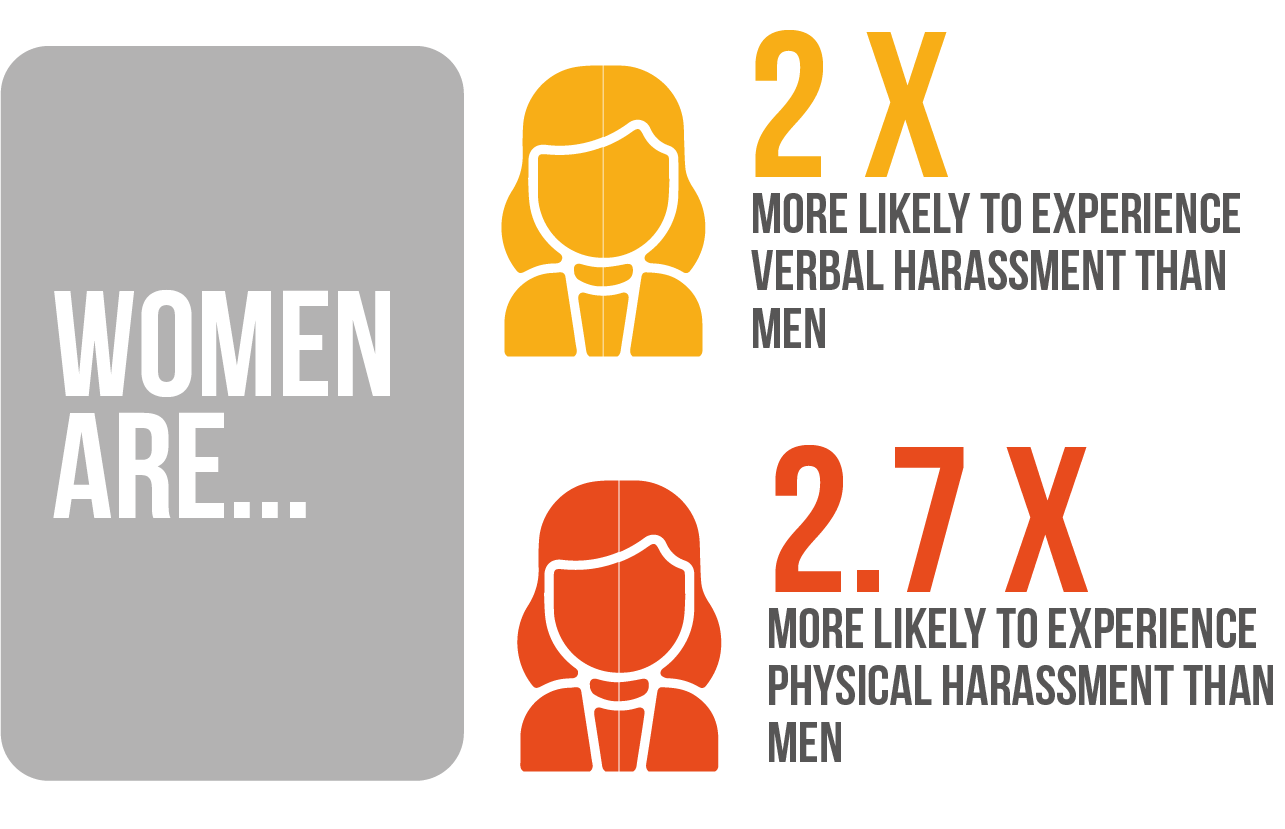
When respondents were asked questions on types of sexual harassment they faced at work women were almost twice as likely to experience verbal harassment compared to men, 52% and 24% respectively. The gap expands more when comparing data on physical harassment (19% and 7%).
Though a small sample size, of respondents who did not specify their gender in the study (almost 15% of the total responses), 29% experienced verbal sexual harassment, 14% experienced physical sexual harassment.
Furthermore, one in two participants stated that they have witnessed sexual harassment - 13.5% five or more times.
The results of this study reveals that sexual harassment is still existing, profoundly, in the media sector, which stresses the need and importance of taking actions to deal with it in an effective way.

Underreporting of sexual harassment is endemic. Providing safe space to talk freely about those cases, and guaranteeing confidentiality and protection are needed, in addition to raising the awareness of speaking up, showing the added value of protecting others from witnessing such recurrent situations.
Yet, of those reported cases, news organisations took actions 46% of the time, a step forward to activate the organisational role in ensuring safety and security of employees at the work environment.
The top reasons listed for not reporting were no known reporting mechanism available (17.3%), not having evidence (13.8%), and not wanting to be negatively labelled (12.8%). The most common responses of organisations when they took action was firing the accused (24.5%), and dismissing with no further action (20.5%).
The reasons for not reporting are brilliantly revealing the way to increase reporting rates: adapt a clear and comprehensive mechanism that applies fair rules, which help change the organisational culture to embracing openness and transparency instead of shame and blame paradox.
AR respondents revealed that the most common source of sexual harassment was a fellow employee (42.9%), followed by direct supervisor (22.2%), higher management (14.6%), other (10.7%), and news source (9.5%).
Numbers show that most sexual harassment incidents happen inside the media organisations at work, whether by the same level of management employees or higher. Firm procedures to help all staff members enjoy a safe workplace is a must.
This research has provided evidence of the need for media organisations to recognise the extent of sexual harassment and put in plans steps to provide a safer working environment.
“It all starts with a conversation on what is and isn’t acceptable behaviour in your media organisation. - being explicit about sexual harassment - sharing definitions, what behaviours are unacceptable, and communicating the right for every employee to be treated equally. It is not enough to have a policy; staff and managers must be trained on what the procedures are for making and managing a complaint. Everyone should be clear about the consequences of sexual harassment. It is far better to be proactive and prepared than pushed into a crisis management position when a case emerges,” said Melanie Walker, Executive Director, WAN-IFRA Women in News.
The media industry in Nicaragua and El Salvador has a sexual harassment problem. On average, 74% of women in media have experienced verbal sexual harassment. More than 40% have experienced physical harassment. These are amongst the highest rates of sexual harassment of all countries surveyed in the 20-country study, completed in November 2021.
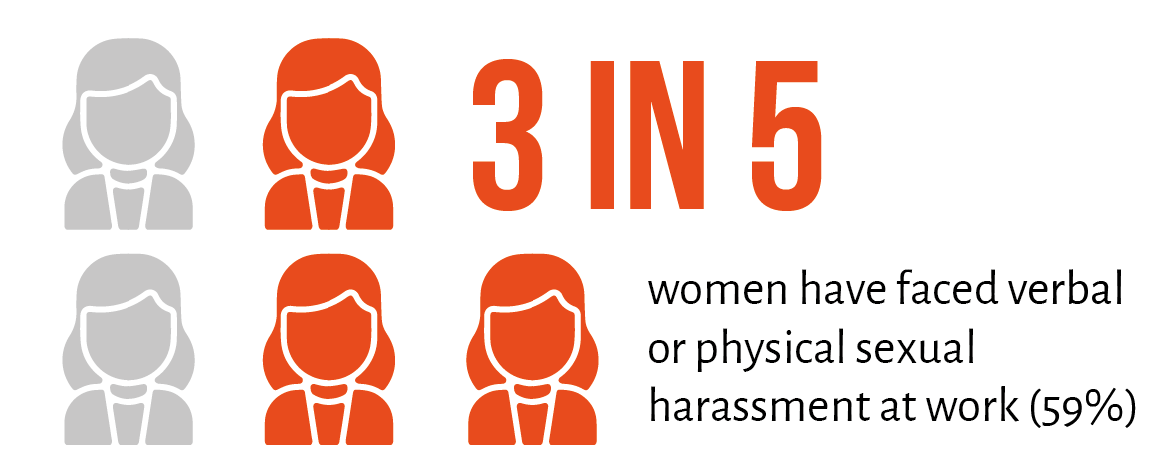
234 media professionals in Nicaragua and El Salvador participated in a survey, in addition to 18 media executives who provided supplementary in-depth interviews to understand the extent of sexual harassment in the industry.
The data shows that women are disproportionately affected, experiencing verbal and physical sexual harassment at least four times more than men. Moreover, women experience sexual harassment far more often than men, with almost half of the women surveyed indicating they have experienced verbal sexual harassment five times or more, compared to 5.8% of men.

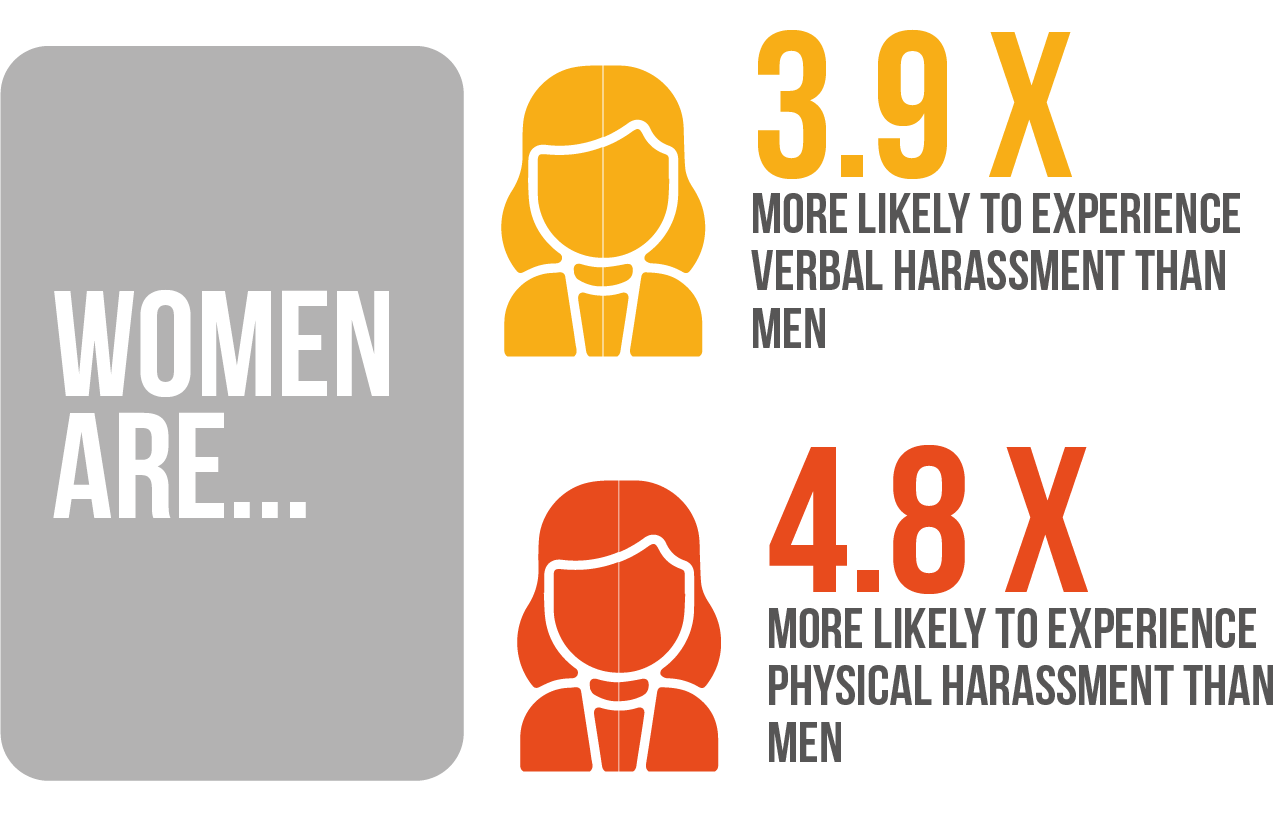
Given these high figures, it is not surprising that almost 60% of the participants had witnessed at least one incident of sexual harassment with 21% stating they had seen five or more. The most common source of sexual harassment was a fellow employee (42%), followed by higher management (25%).
Despite the high prevalence of sexual harassment, on average only one in every four cases was reported. Action was taken in just under half (46%) of incidents that were reported. Responses from both survey participants and news executives indicated the lack of a known sexual harassment policy. This is reflected by the survey respondents, where the top reasons for not reporting cited were ‘no known reporting mechanism available’ and ‘not knowing how to report’. The other reasons for not reporting were ‘fear of perpetrator retaliation’ or ‘fear of a negative impact in their professional career’.
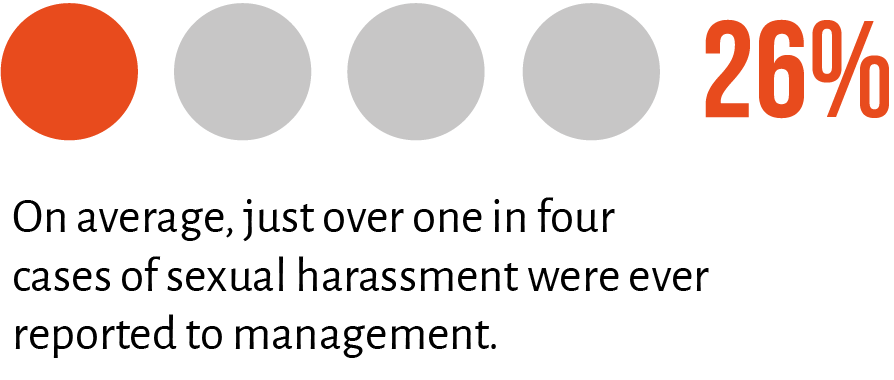
Interestingly, when the interviewed news executives were asked if sexual harassment was a problem, the majority said yes, but not in their newsroom. More than half of the news executives interviewed stated that their newsrooms were exceptions to the overall atmosphere in the news industry, were sexual harassment was common.
The most common responses of organisations when they took action was warning the perpetrator (56.4%), offering emotional support for the victim (16%), and the victim being transferred to another department (10.3%).
Media organisations in Central America need to recognise the extent of sexual harassment and put in mechanisms to provide a safer working environment. The research shows that sexual harassment is a significant problem. The lack of policies aimed at preventing sexual harassment and at addressing it properly when it occurs, along with the common fear to report results in high levels of sexual harassment in the Central American media industry that go largely unchecked.